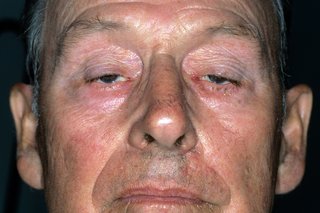Myasthenia gravis causes muscle weakness that typically has times when it improves and other times when it gets worse.
It often affects the eyes and face first, but usually spreads to other parts of the body over time.
The severity of the weakness varies from person to person. It tends to be worse when you're tired and gets better after resting.
In some people, the symptoms can also have other triggers, such as stress, infections and certain medicines.
Eyes, eyelids and face

This can cause:
- droopy eyelids – affecting 1 or both eyes
- double vision
- difficulty making facial expressions
For some people, only the eye muscles are affected. This is known as "ocular myasthenia".
But for most people, the weakness spreads to other parts of the body over a few weeks, months or years.
If you've had symptoms affecting your eyes for 2 years or more, it's unusual for other parts of your body to be affected later on.
Swallowing, speaking and breathing
If the weakness affects the muscles in the mouth, throat and chest, it can cause:
- difficulty chewing
- slurred speech
- a husky, quiet or nasal-sounding voice
- difficulty swallowing
- choking and accidentally inhaling bits of food, which can lead to repeated chest infections
- shortness of breath, particularly when lying down or after exercise
Some people with myasthenia gravis also experience severe breathing difficulties, known as a "myasthenic crisis".
Call 999 for an ambulance immediately if you have worsening severe breathing or swallowing difficulties, as you may need emergency treatment in hospital.
Limbs and other parts of the body
The weakness caused by myasthenia gravis can also spread to other parts of the body, including the neck, arms and legs.
This can cause:
- difficulty holding your head up
- difficulty with physical tasks, such as lifting, getting up from sitting to standing, climbing stairs, brushing your teeth or washing your hair
- a waddling walk
- aching muscles after using them
The weakness tends to be worse in the arms than in the legs and feet.
Page last reviewed: 13 September 2023
Next review due: 13 September 2026